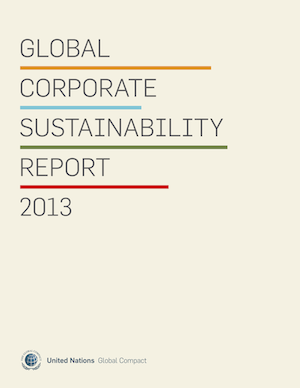The design stage is usually the longest, most expensive and riskiest part of the chain. Additionally, research has shown that at least an estimated 80% of a product's environmental (and to a lesser degree also social) impact is locked at the design stage into a product. By integrating the product design with the supply chain, companies can compress non-value adding time and costs in their supply chains, increase responsiveness and mitigate supply chain risks – while simultaneously managing (improving) their sustainability performance without added costs or efforts.
The UN Global Compact (GC) report published at the beginning of September 2013, and which draws a conclusion on its achievements since 2007 (it was launched in 2000), shows that there is a behaviour-versus-statement gap at corporations. This is worrying.
Sustainability practitioners tend grow a fairly thick skin over time with regards to how their work is valued. Chances are that if you move in a field of expertise that marginally relates to CSR that you'll a surprising selection of comments, that display a lack of recognition.
In the fashion industry we’re very taken to ‘trend’: the colours, cuts, styles, fabrics of the next couple of seasons or so. Yet few venture to think about how their very own industry will look like in, say, 2020 or beyond. Resting the case for the importance of building scenarios of the long-term future.
Australia is a little bit like a big blank spot of knowledge as far as many of us here in Europe (and the US) are concerned.
The recently launched ‘Australian Fashion Report‘ is the first piece of work that looks very specifically at the sustainability and ethical trade practises of brands that are retailed in Australia, both local Australian as well as global brands.
Does sustainability, or not, impact share price? Does it, or not, make for a profitable bottom line business case? Does it, or not, help increase efficiencies? Here the insights from research, and what they mean.
How expensive is fair labour really? This article summarises selected research data to answer these questions. In short: fair labour could be had for cheap.
How expensive is fair labour really? This article summarises research data to answer these questions. In short: fair labour could be had for cheap.
How expensive is fair labour really? What would need to change in the price to make this a reality at the consumer end of fast fashion? This article diggs through some research data that while answering these questions. In short: fair labour could be had for cheap.
The world of sustainability in fashion has changed fundamentally in the last few years. In this article we look at qualities that leaders such as Patagonia's Yves Chouinard have, that make them the movers and shakers of the sustainability agenda in the industry at large.
The first question time discussion in the House of Lords on the topic of sustainable fashion took place on March 3rd, 2011. On March 19th 2013, nearly 2 years later to the day, the 2nd edition took place, again initiated by Baroness Lola Young from Hornsey. The summary
The term ‘circular economy’ has recently been – again – converted into a buzz word. To some extent there are a couple of good reasons for that as both common sense as well as the Ellen McArthur foundation's most recent report prove.
The current fashion and textile landscape is fairly limited in terms of what types of materials are being used. Innovation is key, and products such as Tencel, Sorona and Ingeo proof that industry is investing heavily in R&D. Spider Silk may be one of the few natural fibres of the future yet to see it hayday.
The “Better Consumer” report aims to be a source of reliable information to those executive saying “Show me there is demand, and we'll be happy to cater to it” when asked why their fashion brand is not producing better, more sustainable products.
How can environmental sustainability benefit from small and micro units? And, how can it be ensured that the associated skills sets are unique, yet valuable to the global fashion industry as a whole? Through 2 designer case studies from the UK, and a co-operative in India, we show how different potential solutions could look like.
How can environmental sustainability benefit from small and micro units? And, how can it be ensured that the associated skills sets are unique, yet valuable to the global fashion industry as a whole? Through 3 case studies from South-East Asia we show how different potential solutions could look like.
Puma’s executive have recognised some while ago that their company’s profitability and resilience to competition depends not the least on how well they are able to foresee risks in an area normally just referred to as ‘sustainability’. An overview of their tangible results
Puma’s executive have recognised some while ago that their company’s profitability and resilience to competition depends not the least on how well they are able to foresee risks in an area normally just referred to as ‘sustainability’.
True Cost Accounting is – while far from sufficient – a step forward in the sustainability discussion, beyond the fashion industry. Let's look hence a bit close into what the three large apparel industry initiatives in this area are really about.
Ture Cost Accounting (TCA) requires the quantification of not only the environmental services of our ecosystem, but also the social benefits corporations rely their activities on. With Puma's Environmental Profit & Loss Accounts, the EcoIndex Beta, and the Higgs Index, the apparel industry is at the leading edge in this area.


